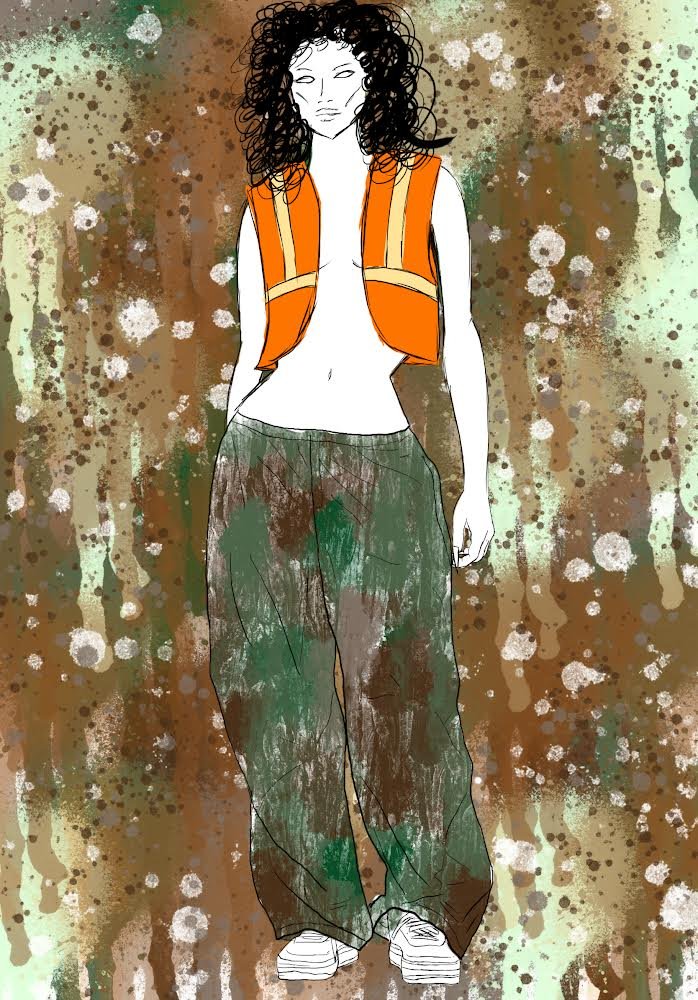The Irony and Yassification of Camouflage Hunting Gear
Art by Christina Casper
You know what I’m talking about.
You are walking down the street. You see a person wearing the green and brown camouflage colors classically attributed to a hunting shirt that you would think would be worn by a guy named Marvin (sorry to any Marvins) who would rather be fishing right now and is in love with his truck named Betty (sorry to any trucks named Betty). But something is…off. Along with the shirt, lies the assortment of accessories, tattoos, and piercings that go with anything but hunting gear. After a bit of analyzing, you can easily identify that this person is wearing the shirt for purely fashion and not sport. AKA, you can conclude that this person is 100% not going to the shooting range but is, in fact, gay as hell.
So, here is the real question: Why?
Why, out of all things, to become the new queer fashion trend, is camouflaged hunting gear taking the front and center?
According to Ryon Alicea ‘27 (they/she), “A lot of it had to do with my access to camouflage pieces from thrifting. I never really saw it as a trend.”
Thrifting, in many ways, has changed the game of fashion and the traditional trend cycle. Not only is thrifting slowing down the damage of fast fashion by providing a more sustainable substitute, but additionally, reusing second-hand clothes has brought back past trends, making some pieces timeless.
Alicea continued by saying, “It is just accessibility that made me drawn to it. I also happen to like the irony of a queer person wearing clothing for conservative males.”
And what made camouflage clothing “for” conservative males? Well, to expand on how people traditionally view camouflage, the military also uses the uniform of camouflage, a group historically dominated by the male population who often strongly believe in and enforce “traditional American” ideals. When it comes to the military, camouflage represents the ideal version of masculinity, its colors and patterns symbolizing purpose, freedom, survival, and power. Camouflage is also typically seen as a uniform: a way to de-individualize and classify who you are within a larger group.
When talking about the irony of a queer person wearing camouflage clothing, it is hard not to mention the “Don’t Ask, Don’t Tell” law: a discriminatory ban that was introduced in 1994 that prohibited out lesbian, gay, or bisexual folks from serving in the military, because being queer didn’t fit into the mold the military had for their image of power. It wasn’t until 2011 that the ban was dropped, allowing some of the LGBTQIA+ community to serve. I say some because it wouldn’t be until 2021 (only two years ago) that transgender folks became able to serve as well.
So, now with the quick runthrough of a history lesson, the rough past between the queer community and camouflage clothing has visibility been an unsteady one. With the nature-filled print often being seen as a discriminatory symbol in the past, which is why the reclamation of this fashion piece in the LGBTQIA+ is so unexpected.
The uprising of queer people making use of camouflage clothes in their wardrobe is the best poster-child example of what it means for something to be “camp.” The first English definition of the term, appearing in the 1909 edition of the Oxford English Dictionary, described the term camp as “ostentatious, exaggerated, affected, and theatrical.” Today the definition has been summed up as being an aesthetic that is appealing because of its “bad taste and ironic value,” which pretty much encapsulates how this pattern is taking the forefront in queer fashion.
Because of this fashion trend, the connotation of these clothing pieces within the confines of contemporary society is changing. Sure, camouflage will always have its roots in these institutions, but deep down it is meant to represent resilience, power, and purpose. And while wearing camouflage may seem “purposeless” outside of military uniforms and hunting attire, many queer people have taken on the fashion choice as a way of reclamation—a way to display the progress that’s been made for queer rights. In this way, wearing camouflage clothing truly does express the taking back of power within the LGBTQIA+ community.

